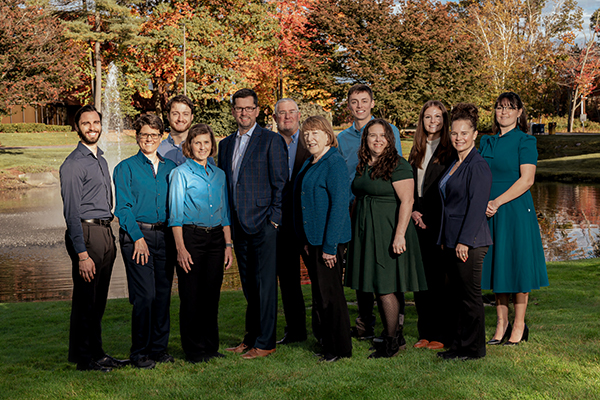
Turning 50 years old marks an important milestone in financial planning. Life events align at this point to make retirement feel closer. Children may be getting older, close friends or family may be retiring or preparing to retire, the urge to work on your lifetime bucket list may be getting stronger. The need to plan may feel less urgent than , yet planning at this stage has the critical advantage of time. Financial planning strategies provide exponentially greater rewards the earlier they are implemented. Commencing a strategy in your 50s will provide far greater long-term benefits than the same strategy implemented in your 60s, so don’t delay! For many, this is the last full decade to save, plan, and make sure you are on track to meet your long-term goals. Planning at this stage is supported by generous tax advantages conferred by the IRS to savers. These years may represent the peak of career earnings, further enhancing the capacity to gain ground in one’s planning.
At the same time one is looking ahead to retirement, significant life events will be taking place in this decade that require energy and planning of their own. There is perhaps no other point in the planning life cycle where it is more important to be balancing the planning needs of your future with those of the present.
Life Changes
Recent history has seen a much greater variety of timelines for family life in America and beyond. For some, the life changes outlined here may occur well ahead of or well after your 50s. Whenever these events occur for you, they represent inflection points in planning where the decisions made will have outsized consequences for many years into the future.
Education Expenses
At this stage, individuals and couples with children may see their offspring leave home, attend college, or enter the workforce and begin to support themselves. If supporting children’s education financially, finances may be strained by the additional expense of higher education bills. When children begin to support themselves, the reduction in expenses may result in a cash flow surplus, perhaps the largest surplus of one’s career. In all but a select few cases, education costs will represent a strain on current cash flow. If you have some time before incurring these costs, you may be able to top off your savings. If not, planning may shift to how best to use available resources to finance education bills.
However urgent paying for education may feel, it is critical at this stage to stay the course on retirement planning and savings. There are several products and policies in place that support education funding as a national priority, from student loans to financial aid and tax credits. Retirement, particularly if you plan to retire ahead of enrolling in Medicare or claiming Social Security benefits, requires a much greater degree of self-sufficiency. Retirement planning will need to remain a priority even in the midst of a high level of pressure to fund education.
An Empty Nest
At the same time as education costs may present a challenge to cash flow and planning, there may be a significant shift in lifestyle and family life as children begin moving away from home to attend college or establish their own homes as they begin their careers. This change provides a chance to practice what living in retirement will feel like. New activities can be cultivated that can provide a sense of purpose and community in retirement. Taking staycations allows you to experience living at home without children and without a job. Living off your projected retirement budget will ensure you are comfortable with the type of retirement lifestyle your portfolio can support.
Aging Parents
At this point in their lives, many individuals contend with aging parents who may need an increased level of care. This care requires resources in the form of time providing or coordinating care, as well as the financial resources to fund these needs. Depending on the circumstances, you may be the primary individual watching over the care of a parent at this stage.
Oftentimes, coordinating care is one of the most time-consuming and stressful aspects of caring for an aging parent. The often-complex care needs of aging parents may require communication with medical specialists, nursing services, and providers of basic needs such as meal preparation and transportation. A transition of a parent to a nursing home, assisted living facility, or continuing care community greatly reduces the need for this coordination, but comes at an increased financial cost.
Insurance policies vary widely in the types of services covered and the selection of providers an insured may choose from. Health insurance plans including Medicare will provide limited, if any, coverage for care related to basic lifestyle needs rather than the diagnosis or treatment of a medical condition. If parents have long-term care insurance, the scope of this coverage will be broader, but the dollar amount of coverage provided will usually be limited. Both health plans and long-term care insurance coverage may require pre-approval for some types of care and may limit providers to a preferred list or offer financial incentives for doing so.
Where aging parents have resources of their own to fund their needs beyond what insurance will cover, care will need to be taken to manage resources effectively. Where appropriate, a durable power of attorney can grant children the ability to assist in managing financial resources directly if parents are unable to effectively manage their finances. A qualified advisor with experience in elder care issues can be an important resource to assist in utilizing assets effectively and to make the most of assistance available through government benefits and private insurance programs. If parental resources are limited, increased governmental assistance designed specifically for individuals with few resources may be available. If you are considering providing financial assistance directly, the same caveats discussed around education funding apply here in terms of protecting your own retirement goals while providing what assistance you can to aging parents.
Retirement Planning
During the earlier working years, retirement can often feel like a lifetime away. At this stage, it can begin to feel much closer. With the realization that time to retirement is much more limited than it once was, this is a good time to review your overall plan and assess your goals. By now, some of the unknowns of retirement planning may become clearer, and a more detailed plan may be developed. Concrete steps can be taken to improve the outcome of your plan and add security if one or more aspects of your plan changes over time. While numerous considerations may arise in any one individual’s situation, several strategies that can greatly enhance the retirement outlook are common to most plans at this point.
Qualified Catch-Up Contributions
The Internal Revenue Code (IRC) itself was drafted with the understanding that this decade represents a chance to step up retirement readiness efforts. In the year in which you turn 50 years old, contribution limits are increased for a variety of tax-advantaged retirement accounts. These additional contribution amounts, called “catch-up contributions,” vary by type of retirement plan. Like other contribution limits, they also increase over time with inflation. Here are some of the more common types of catch-up contributions with their permitted amounts for the 2024 tax year:
- 401(k), 403(b), 457(b): $7,500 catch-up ($30,500 total)
- IRA and Roth IRA: $1,000 catch-up ($8,000 total)
- SIMPLE IRA: $3,500 catch-up ($19,500 total)
And the landscape continues to evolve with respect to enhanced retirement plan rules for older employees. The SECURE 2.0 Act of 2022 contains several provisions impacting catch-up contributions.
One provision requires catch-up contributions for high-income individuals earning over $145,000 per year to be characterized as Roth contributions when made to a 401(k) or similar type of plan. Currently, this provision is under a delay to 2026 to allow plan providers and sponsors time to implement this change. This rule does not apply to IRA accounts including SIMPLE IRAs or SEP-IRAs.
Another provision has formally indexed the $1,000 IRA catch-up amount to inflation, making future increases more likely. The current $1,000 value has been in place since 2006.
Lastly, while outside the direct scope of this post, it should be noted that the act instituted an additional tier of catch-up amounts for employees who are 60, 61, 62, or 63 years old. Beginning in 2025, employees in this group will have the base catch-up amount increased by the greater of 50% of the basic catch-up amount or $10,000.
If you are eligible to contribute to a Health Savings Account (HSA), the IRC permits increased contributions here as well. Unlike the other plans mentioned in this article, you are not eligible for catch-up contributions to an HSA until age 55. For 2024, the catch-up amount is $1,000 per eligible insured. Total contributions to an account could range from $5,150 for an individual to $10,300 for two spouses who are both over age 55 and covered by a qualifying family health plan. If you can, contributing to your HSA while funding current healthcare costs with after-tax dollars outside of this account enhances your retirement portfolio. Prior to retirement, HSA dollars may be invested and will grow tax-deferred in the same way that retirement accounts do. In retirement, assets accumulated in your HSA may be withdrawn tax-free to fund a variety of healthcare costs.
Other Saving Opportunities
While contribution limits to tax-advantaged accounts become more generous at this point, what should one do if the need to save exceeds these limitations? Depending on your goals, it may be a significant mistake to believe that tax-advantaged savings opportunities alone will provide for a secure future. A variety of additional strategies may be incorporated into your plan over and above traditional retirement accounts to provide for a higher level of savings, a more diversified portfolio, and greater opportunities for future tax planning.
One often-overlooked option is to utilize taxable investment accounts to complement tax-advantaged retirement plans and IRAs. Taxable accounts provide no current-year deduction for contributions, and most accounts will incur some amount of tax liability each year. However, these accounts are supremely flexible with no limitations on the amounts you may contribute and no penalties for distributions at any age. Accounts may be owned individually, jointly, or by a revocable trust based on individual needs. There are no limitations to investment choices. With thoughtful management, the tax liability incurred from these accounts may be managed year to year to best suit one’s plan. Most forms of dividend and interest income are taxable in the year in which they are received, but capital gains from appreciated assets – such as when the price of a stock rises from $10 per share to $12 per share – are deferred until that stock is sold. An attentive manager will be able to balance taxable income, tax-exempt income, and capital gains to minimize the impact taxes from this account will have on one’s plans.
Plan for the Unexpected
Retirement planning entails many assumptions. Its nature is to prepare for a future largely unknown. A high-quality plan will look at the most likely course of events and contain contingencies if the future does not unfold as expected. These contingencies may relate to the performance of financial markets or the rate of inflation, where prudent investment management and cash flow planning can insulate a plan against a variety of possible market environments. Other contingencies relate to life events such as the premature death of a spouse or a forced early retirement as the result of a health condition or layoff. Working with your advisor to build multiple scenarios into your plan, carefully reviewing your entire insurance portfolio, and making sure your estate plans are current will all go a long way toward insulating your plan against the unexpected.
Conclusion
The 50s represent a pivotal decade in planning. This period is both an important transition time between the working years and retirement, as well as a time in which a host of important life events may be occurring in their own right. It is not uncommon to seek out a financial advisor for the first time at this point in life as multiple goals begin to compete for attention and the time horizon for meeting these needs becomes more limited. We are here to help. If you would like to arrange a time to discuss any of the ideas here and how they may relate to your own unique circumstances, please reach out to our team.
Disclaimer: This is not to be considered investment, tax, or financial advice. Please review your personal situation with your tax and/or financial advisor. Milestone Financial Planning, LLC (Milestone) is a fee-only financial planning firm and registered investment advisor in Bedford, NH. Milestone works with clients on a long-term, ongoing basis. Our fees are based on the assets that we manage and may include an annual financial planning subscription fee. Clients receive financial planning, tax planning, retirement planning, and investment management services and have unlimited access to our advisors. We receive no commissions or referral fees. We put our client’s interests first. If you need assistance with your investments or financial planning, please reach out to one of our fee-only advisors. Advisory services are only offered to clients or prospective clients where Milestone and its representatives are properly licensed or exempt from licensure.



